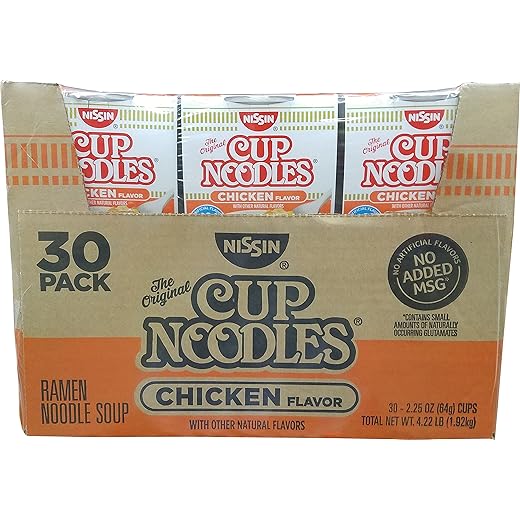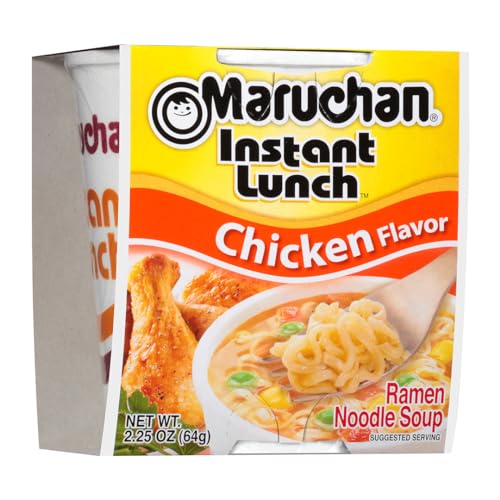Which bowl wins on protein, sugar, taste, and price per serving—Nissin or Maruchan; a friendly, balanced breakdown compares protein counts, sugar content, flavor and cost, then ends with a concise buying guide to help you pick the best grab‑and‑go chicken bowl.
Hungry for a verdict? Quick comparison of Nissin Cup Noodles (30‑pack) and Maruchan Instant Lunch (12‑pack) focusing on nutrition, taste, convenience, and value, so you can pick the best chicken bowl for your cravings and budget — quick, clear, unbiased guidance.
Pantry Staple

Solid everyday option for anyone who wants a dependable, easy hot meal with classic chicken flavor. Best for pantry stocking or when you want a quick bowl with predictable taste and texture. Expect convenience and consistency, but be mindful of sodium and price-per-cup compared with budget brands.
Budget Staple

A budget-friendly, dependable instant cup that delivers familiar chicken flavor and great price-per-serving. Ideal for students, office lunches, and emergency pantry stashes where cost and convenience matter most. Keep an eye on sodium and consider adding protein or veggies to make it more filling.
Nissin Chicken Cups
Maruchan Chicken Cup
Nissin Chicken Cups
Maruchan Chicken Cup
Nissin Chicken Cups
Maruchan Chicken Cup
Nutrition Face-Off: Protein, Calories, Sugar & Sodium
Quick nutrient snapshot (per single cup/serving)
These are typical ranges — always check the exact Nutrition Facts on the product page because recipes and formulations can vary by region.
Ingredients, additives & allergen notes
Both bowls use instant wheat noodles plus powdered chicken broth and seasonings. Common additives include hydrolyzed vegetable protein, monosodium glutamate (MSG), disodium inosinate/guanylate, and preservatives like TBHQ in small amounts. Both usually list wheat and soy; may also contain or be processed in facilities with egg, milk, or shellfish.
Watch for these on the label:
How to read the Nutrition Facts on Amazon
Open the product page, scroll to “Product details” and image gallery — many sellers include a photo of the Nutrition Facts panel. Confirm serving size (usually “one cup” or “one container”) and servings per container. Serving size matters because calories/protein/sodium are per serving — a larger bowl or adding extras changes totals quickly.
Typical differences customers mention
Users often report Nissin feels a bit heartier — slightly more protein and a richer broth — while Maruchan is marginally cheaper per cup. Sodium is high in both; Nissin can trend slightly higher depending on batch.
When to choose which & quick upgrades
Easy swaps/add-ins to improve nutrition:
Side-by-Side Feature Comparison
Taste Test: Flavor, Texture & User Feedback
Broth & Flavor Profile
Nissin: richer, slightly more savory broth with a clearer “chicken” note — some reviewers call it heartier and less one-dimensional. Tends toward a stronger, slightly saltier finish.
Maruchan: milder, more Reliant-on-seasoning-powder taste; familiar comfort-flavor that many describe as “simple and satisfying” rather than authentic. Both lean toward savory/umami over spicy; neither tastes restaurant-grade — more of a convenient savory hit.
Noodle Texture & Hold-up
Nissin: noodles often feel a touch firmer and chewier after hot water, holding texture a bit longer.
Maruchan: softer sooner; fine if you eat quickly but can get mushy if left standing. Both rehydrate in ~3 minutes and have similar wheat-ramen mouthfeel.
What Amazon reviewers say (common themes)
Quick tips to boost flavor
Which to pick
Convenience & Prep: Cups, Packs, Microwaving & Portability
Quick prep methods
Both cups are designed for hot-water prep: peel the lid to the fill line, pour boiling water, cover and steep ~3 minutes, then stir and eat. Microwaving is sometimes possible but not guaranteed—always check the cup label. If the plastic cup isn’t labeled microwave-safe, transfer noodles and water to a microwave-safe bowl before heating. Beware of super-heated liquids and use oven mitts.
Packaging & storage
Nissin: 2.25 oz cups sold as a 30‑count bulk (67.5 oz total) — great for stocking a pantry, but takes more shelf space.
Maruchan: 2.25 oz cups in a 12‑pack — smaller box that’s easier to stash in a dorm or office.
Both cups contain integrated powdered seasoning (no separate sachets) and rehydrate quickly. Maruchan often lists small dried veggies in the cup. Unopened cups store long-term — typically many months to a year in a cool, dry pantry.
On-the-go usability & cleanup
Cups are ultra-portable and light. For camping, a small stove/kettle and mug suffice. For dorms/offices, a kettle is the most convenient tool; a microwave is a backup if the cup is microwave-safe or contents are transferred. Cleanup is minimal — mostly disposable cup and a spoon — but generates plastic waste.
Workplace checklist & storage tips
Price Per Serving & Value: Which Bowl Gives the Best Bang for Buck?
How to calculate price per serving
Take the Amazon pack price ÷ number of bowls. Factor in any shipping or tax by adding those costs to the pack price first. Example formula: (pack price + shipping + estimated tax − coupon) ÷ bowl count = final price per serving.
Example math (using listed prices)
Add shipping to see the impact:
Promotions, subscribe & save, coupons
Adding extras — still budget friendly?
Typical add‑ins (rough estimates): 1 egg $0.20–$0.40, a scoop of frozen veggies $0.20–$0.40, leftover chicken $0.75–$1.50.
Who should buy which?
Choose based on the real final price per serving (after shipping/coupons) and whether you’re willing to pay a bit more for taste or extra protein.
Final Verdict & Quick Buying Guide
For most shoppers, Nissin Cup Noodles Chicken takes the win: reviewers praise its stronger seasoning and slightly better texture, making it the best taste-forward pick, while still offering comparable protein and sugar to Maruchan. If lower price-per-serving matters more, check current Amazon listings — Maruchan packs (12 or larger multipacks) often edge out on cost. If protein or lower sodium is your priority, pick the product with the higher protein and lower sodium per serving on the product page, or add lean chicken, egg whites, and lots of veggies to any bowl to boost nutrition.
Quick buying tips: compare price-per-serving, read nutrition labels on Amazon, buy bulk only if you’ll finish it, and toss in simple add-ins (grilled chicken, spinach, or frozen veggies) to cut sodium impact and up protein. Happy slurping and choosing!














